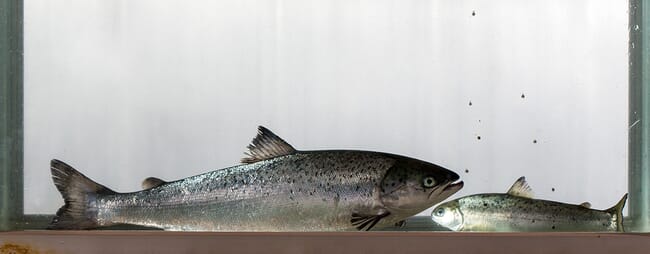A trial undertaken as part of the CtrlAQUA project showed that fish that were transferred from land-based facilities at 100g grew better than those transferred at 600g, surprising the researchers involved.
Methodology
The trial started with 30 gram salmon juveniles in tanks with recycled water at Nofima’s research facility in Sunndalsøra. The control group were smoltified by light control (winter signal) and were transferred to the sea as 100 gram smolt in August. The other groups were either exposed to 24-hour light for the entire land-based phase, or given a winter signal with a short day for six weeks as the control fish. Both light regimes were tested in both freshwater and brackish water, and the fish were transferred to the sea at around 200 grams in October or 600 grams in December. The fish were slaughtered at the end of November the following year, when they had reached around four and a half kilos.
Results
The most efficient production regime in the RAS involved the use of brackish water combined with 24-hour lighting for the entire phase. The positive effect on growth by not giving the fish a winter signal was greatest when the fish were 200 grams, but still noticeable when transferring the 600 gram fish.
The fish with the best overall growth were, however, those that were transferred to sea at 100 grams after undergoing traditional smoltification. The fish that were 600 grams at the time of transfer had the poorest growth in the marine cages. The latter ate little during the first three weeks in the sea, and had poorer growth in the summer. Although there were growth differences between the groups, all groups had good growth compared to the performance in commercial farming, with growth factors (TGC) between 2.9-3.3 in the sea phase.

© Terje Aamodt, Nofima
What was perhaps most surprising, say the reserachers, was that the fish in all of the production regimes endured the transfer to seawater, even though not all were smoltified in the traditional way by light control. Survival in the sea phase was 93 percent, and there were no differences between the groups.
“It appears that salmon are quite flexible with regard to time of transfer to seawater, and this provides opportunities for several different production strategies,” researcher leader Trine Ytrestøyl says.
Sexual maturation
Early sexual maturation among male fish is a problem in land-based salmon production. Sexual maturation is affected by light regime and temperature that control the growth rate.
“We saw a clear tendency towards higher rates of sexual maturation among male fish in the RAS facility when they had reached 600 grams, compared to when the fish were 100 and 200 grams. But we found no clear correlation between light regime or salinity in the recycling facility and sexual maturation,” Ytrestøyl said. “In the sea phase we found very few sexually mature male fish. Perhaps a greater proportion of the male fish would have become sexually mature if they had remained in a recirculating facility until slaughter, but this was not tested in this trial.”
Conclusion
The researchers’ conclusion is that several strategies may be used for the production of young salmon in an RAS and that the most effective production regimes in an RAS don’t necessarily result in the best growth in the sea phase. However, for a fish farmer, it may be of greatest importance to minimise the time in the sea.
Because the fish had different production times in the land phase, they were transferred at different times in the autumn, at different temperatures and day lengths.
“These are factors that affect the growth patterns of salmon, and we should therefore be cautious before drawing conclusions on which production regimes in recirculating facility that are best with regard to growth in the sea. However, based on the results of this trial, a traditional smolt of 100 grams was the most effective strategy,” Ytrestøyl says.
It remains to be seen whether one would have achieved the same results if the fish had been transferred to sea in the spring, at a time of rising sea temperatures and longer days.
Ytrestøyl nevertheless emphasises that in order to reduce the risk of escape and sea lice, it is sensible to reduce the time the salmon spend in the sea. This illustrates that there are many unanswered questions with regard to how large post-smolt should be produced, and how the season at the time of transfer affects performance in the sea phase. Research will continue into these issues at CtrlAQUA.


